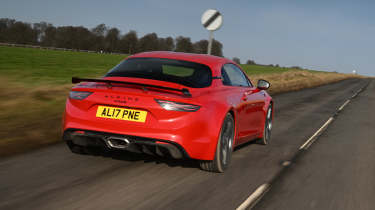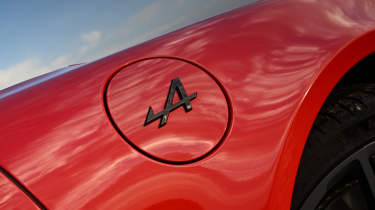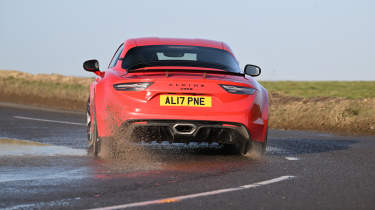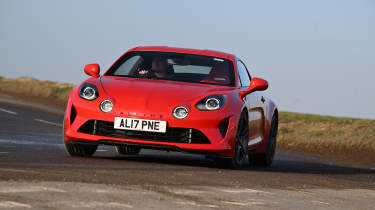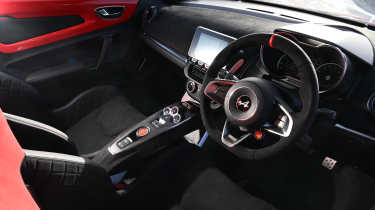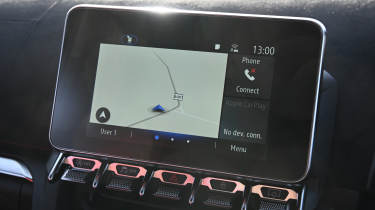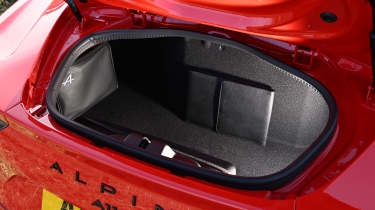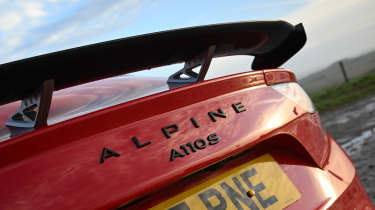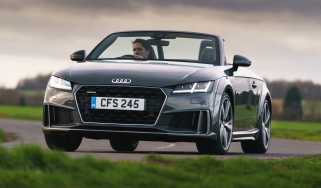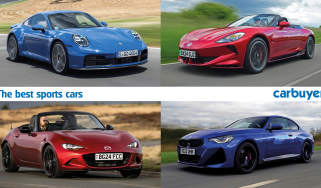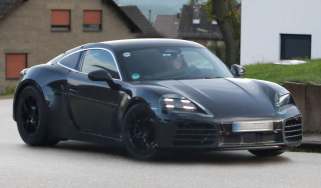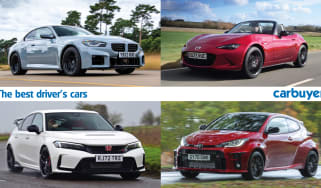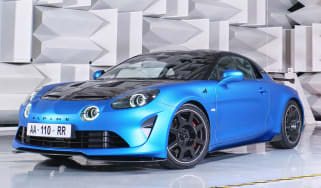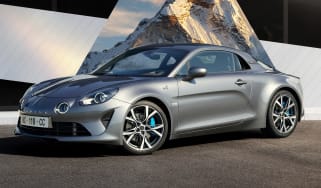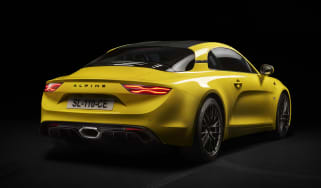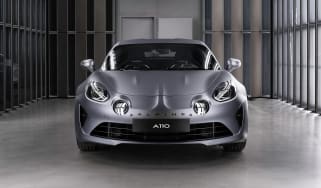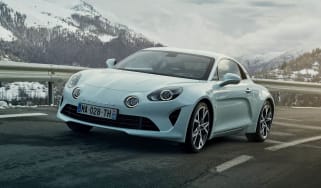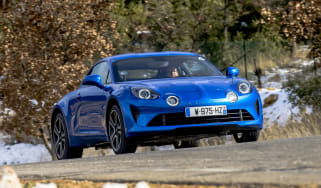Alpine A110 review – sporty and yet economical
“The Alpine A110 is a mid-engined sports car that’s fast, fun and surprisingly cheap to run. Just don’t expect to carry much with you”
Pros
- Great to drive
- Stunning design
- Low running costs
Cons
- No manual gearbox
- Limited luggage space
- Less upmarket than a Porsche
Verdict – is the Alpine A110 a good car?
The Alpine A110 was a welcome addition to the relatively sparse modern sports car market when it launched. It’s great to drive, looks the part and its economical engine means running costs are lower than most of its rivals, too. The downside is that there’s no manual gearbox option which could be disappointing for enthusiasts, and while it’s surprisingly comfortable for a sports car, limited luggage space means it’s less viable as your sole car.
Alpine A110 models, specs and alternatives
Renault revived the name of classic French sports car brand Alpine with the A110 as its first production model. Based on the design of a sixties legend that found fame in rallying, it’s a successful homage to the much-loved original, but naturally, it’s much quicker and more modern. The Alpine A110 is a welcome extra choice for driving enthusiasts who have a relatively narrow selection of sports cars to choose from these days.
Rivals to the Alpine A110 include the BMW 2 Series M240i, Porsche 718 Cayman, Lotus Emira and Ford Mustang. The Mustang was part of a twin test with the A110S, and the French car won because its light weight and compact dimensions make it incredibly nimble and composed through the corners, so it fulfills its brief well. The Mustang is admittedly a very different beast and it’s a little more practical everyday, though the Alpine’s smaller engine makes it more economical to run, if that’s a priority.
Power comes from a rorty 1.8-litre turbocharged petrol engine with 249bhp in the standard A110 or 296bhp in GT, S, and R specifications. It’s the same engine found in the Renault Megane RS, but here it only has one tonne of metalwork to get moving. This means 0-62mph is dispatched in just 4.5 seconds in the standard A110, with this sprint even quicker in the more hardcore models, putting it on a par with its rivals. Yet, despite its performance, whooshes and rasps, the A110 can still return fuel economy of around 40mpg, bringing surprisingly agreeable running costs.
Renaultsport engineers have more experience with front-wheel-drive hot hatchbacks, but that hasn’t held the rear-wheel drive mid-engined Alpine A110 back. Light, communicative and accurate steering makes threading it along a twisting road or track a delight. A low centre of gravity and great balance mean it can flick from one direction to the next in an instant. It also has a supple ride, making it more comfortable than the Porsche or Audi.
For even more power, GT, S, R Turini and R models come with 296bhp. GT is aimed at less hardcore buyers who still want this power combined with comfort, and it answers criticism that the A110 isn’t fast enough in a straight line. It also gets a number of extra features thrown in, but it is significantly more expensive.
A small amount of the A110’s everyday comfort is lost in the more hardcore A110S, due to springs that are 50% firmer and anti-roll bars that are twice as stiff, but it's a testament to the work of Alpine's engineers that the mid-engine sports car is still a great car in which to travel, as well as generating more grip and handling even more precisely.
The Alpine A110R is the most hardcore model you can buy, and it’s 34kg lighter than the standard car thanks to lighter carbon fibre panels and sits 10mm lower than the A110S. This model is mainly aimed at buyers looking for a car to enjoy around a track, although it’s still road legal. It’s expensive, but for a no-nonsense sports car the A110R is worth the extra if you can afford it.
The A110’s interior is spacious enough for a tall driver and passenger, with supportive and comfortable seats and decent visibility. The dashboard layout is simple, with an infotainment display hovering in front of the fascia and a simple row of toggle switches under it. The centre console is a thin spine with push buttons for the automatic gearbox and a prominent red starter button. It's less brutally simplistic than the Alfa 4C, but can’t quite compete with the Porsche 718 Cayman or Audi TT for plushness or build quality. The seven-inch touchscreen has enough features but looks a bit cheap, both in terms of its graphics and its big plastic surround.
Luggage space could also be a deal breaker for some, with just 100 litres in the boot and a similar amount under the bonnet. Think of the Alpine as a fun weekend toy and it’s unlikely to be an issue, but a TT, Cayman or even a Toyota GT86 can carry more if you plan on taking your sports car on holiday.
In most respects, though, the Alpine A110 is a surprisingly good all-rounder. It feels special and doesn’t beat you up with a rock-hard ride or uncomfortable cabin, yet still has plenty of performance and sublime handling. Happily these come without the usual sports-car caveat of sky-high running costs. If you can justify its higher price, the A110S is even more exciting to drive and is destined to become a classic.
MPG, running costs & CO2
When a manufacturer builds a lightweight car with a small and efficient turbocharged engine, it’s a lot easier to achieve a balance between performance and fuel economy. This is exemplified by the Alpine A110, which is a 'proper' sports car that can return up to 40.9mpg – a similar figure to many crossovers. It beats the Porsche 718 Cayman, where 30mpg seems almost unreachable. It’s much more economical than a V8-powered Ford Mustang, too, which can only muster up to around 23.5mpg.
CO2 emissions of 152-160g/km are impressive, too; they're well below the Porsche’s and keep the A110 out of the very top Benefit-in-Kind (BiK) bands for company car drivers.
Costing over £40,000, every Alpine A110 will be liable for an extra road tax surcharge in years two to six of ownership, resulting in an annual payment of nearly £500. It'll revert back to the standard rate in subsequent years. Insurance costs should be similar to the Porsche Cayman S, which occupies the same group 44 classification, while the Audi TT RS should cost a little less – it sits in group 43.
Exclusivity should mean the A110 will keep a firm grip on its value when it comes time to sell, and there should be a healthy demand. UK cars get a three-year/60,000-mile warranty – the same as a Renault Clio or Megane. Servicing costs have yet to be announced, but only a handful of UK Renault dealers are currently authorised to sell or service Alpine cars, which could be inconvenient depending on where you live.
Engines, drive & performance
Not only is the Alpine A110 fitted with the same 1.8-litre turbocharged petrol engine as the Renault Megane RS, but it’s also built on the same production line in Dieppe, France too. The fact it has been engineered by the people responsible for some of the world’s finest hot hatchbacks certainly adds to its credibility among driving enthusiasts.
Unlike the Megane, though, power is sent to the rear wheels and the engine is behind the front seats. The A110 follows the same mid-engined pattern as the limited-run Clio V6 of the noughties, but is nothing like as difficult to drive as that car. Control is helped no end by its advanced electronic safety net, which offers Normal, Sport or Track settings to alter the response of the automatic gearbox, throttle, steering and even the exhaust note while ensuring stability and traction.
An aerodynamically smooth underside helps the Alpine to remain stable at speed, and the brakes are responsive and full of feel. Head into a corner and the steering is precise and provides plenty of feedback without being overly heavy, and there’s lots of grip. The car weighs 1,080kg, so there’s little inertia and changing direction feels almost instantaneous. The A110 is also nearly perfectly balanced, with 44% of its weight over the front wheels and 56% at the back. If you want to provoke the rear to slide, it'll play along, but unlike the docile Mazda MX-5, the A110 will eventually spin when all its electronic aids are switched off.
Its suspension is softer than the Porsche Cayman S or Audi TT RS, but this doesn’t make it any less involving, and the extra compliance helps the A110 live with the bumpy tarmac found on most British roads. We've only tried it on 18-inch wheels, but suspect the standard 17-inch alloys would make it even more compliant over rougher surfaces.
The 249bhp engine makes all the right noises, hissing behind you as the turbo releases pressure and howling as you accelerate up through the gears. Acceleration from 0-62mph takes 4.5 seconds, which is a little slower than the more powerful Porsche Cayman S and Audi TT RS, and the top speed is 155mph. The A110's turbocharged engine does hesitate briefly when full power is called upon, but the engine performs strongly from 2,000 to 5,000rpm At this point it’s best to change gear – one criticism is that this can sometimes feel a little soon, but the Alpine is more fun to rev than the Porsche. While it might not be quite as rapid off the mark, the A110’s short gearing does make it extremely quick between 30-50mph and 50-70mph, giving it great corner-to-corner speed and overtaking capability.
 The top 10 best sports cars in 2025
The top 10 best sports cars in 2025
With 296bhp, the GT, S and R versions sit at the top of the range and fit the bill if you’d prefer the A110 with more power. The engine sounds louder but more importantly its extra power shaves three-tenths off the 0-62mph time in the GT and S, and six-tenths off in the ultra-lightweight R. Its top speed stays the same in the GT model, but is increased to 161mph in the S model and 177mph in the R.
Adding to the S model’s more focused feel is suspension that's considerably stiffer, a large set of Brembo brakes and wider Michelin Pilot Sport 4 tyres as well as a large rear spoiler and front splitter.
It might not be quite as supple as the standard car, but it still feels well-suited to British roads and darts into and out of corners very keenly. The steering and brakes feel sharper, especially when turning into a corner, and there's a lot more grip. The A110S rolls less in corners and seems more stable than the regular car. Both the GT and S have a much higher price and we’re sure that most buyers would be delighted with the standard A110, but if you really want to scratch that sports car itch, you’ll probably appreciate the upgrade.
Inspired by the Alpine F1 team, the R model takes it even further, getting lots of weight-saving features such as carbon fibre panels, more extreme spoilers, splitters and aerodynamic bodywork, and even lower, stiffer suspension. This model is aimed at those who want out-and-out performance for the track above all else.
Following the disappointing gearbox of the Clio Renaultsport some might have been worried that the A110 is only available with an automatic seven-speed transmission. Fortunately, this one is far better, with crisp changes and an immediate response when you grab one of the steering wheel-mounted paddles. It’s not quite as impressive as the Cayman’s PDK automatic, but it’s quick enough to excite ardent driving fans.
Interior & comfort
In an effort to stick close to its ancestor and keep weight down, the A110 is unsurprisingly compact and light. Somehow, though, this has been achieved without entirely abandoning comfort and interior style, and the Alpine feels rather more plush inside than some rivals.
Quilted leather abounds and the raised central console helps to create a feeling that you're hunkered down in the machine. The standard seats are good, but the optional sports seats provide extra support without feeling too hard. A set of digital instrument dials adds a real motorsport feel, and their appearance changes depending on which driving mode is selected.
The Alpine is quite well equipped, too. Features such as LED lights and auto wipers are standard, along with alloy wheels from Fuchs – a company famous for producing Porsche 911 wheels. There's a seven-inch touchscreen infotainment system with DAB radio, Apple CarPlay and Android Auto, and driver aids include hill-start assist and emergency brake assist. It seems a bit miserly that parking sensors aren’t fitted as standard, though.
Go for the GT and you gain front and rear parking sensors, a brown leather interior as standard (this can be swapped for the standard black leather), heated seats and a premium Focal sound system.
Choose the A110S and you'll be greeted with orange stitched upholstery on the roof lining, sun visors, door panels and centre console, along with a standard telemetrics device to display and record driving data. The A110S also gets parking assistance, aluminium pedals and an upgraded Focal stereo. From the outside, the S model is distinguished by a big spoiler, black and carbon badges, orange brake calipers and anthracite GT Race alloy wheels. The GT model sits between the two, offering a more refined take on the most powerful engine option.
The rear glass in the R models is replaced with a weight-saving carbon fibre panel, and certain features such as parking sensors cannot be specified, although a reversing camera is still available. The tyres are upgraded for the track, with Michelin PS Cup 2 rubber on the A110R, and uprated Brembo brakes with improved cooling for heavy-duty use. It also gets a central tailpipe, unique translucent taillights, and a black microfibre headlining and bucket seats on the inside.
Practicality & boot space
The Alpine A110 feels rather more conventional than some of its sports-car rivals. The French car has much narrower door sills and to negotiate when getting in and out, and the doors open more widely, too. You’ll also find decent amounts of space for the driver and front passenger, with supportive quilted leather seats that hold you firmly in position without being too hard.
For the vast majority of owners, the Alpine A110 won’t be their only car – and that's probably a good thing. That’s because in the back there’s only a 100-litre boot, making the A110 far less practical even than a city car. Luckily, there’s another storage space up front, of a similar size, but even combining the two provides far less storage than the Porsche 718 Cayman. Still, think of the A110 as a pure sports car for use at weekends and it makes more sense. After all, it weighs around 300kg less than a Cayman, which is no heavyweight itself.
If you’re looking for a sports car that’s a little more practical, the Ford Mustang has four seats and a very usable boot. It even gets ISOFIX mounts if you need to attach a child seat, which can’t be said for the Alpine.
Reliability & safety
While Alpine might not sell cars in high enough numbers to feature on the 2024 Driver Power customer satisfaction survey, its parent company Renault does. The bad news is that Renault comes in a disappointing 28th place out of 32 manufacturers in the survey. Reliability is pretty average, with 24.4% of Renault owners reporting an issue with their car in the first year of ownership.
The fact that the Alpine appears well built is promising, though, and its engine and automatic gearbox – also found in the heavier and more mass-produced Megane Renaultsport – should be relatively unstressed due to the A110's light weight, which must be good news for reliability.
Likewise, safety will remain somewhat unknown until independent experts Euro NCAP crash-test an A110. However, Renault has an excellent safety record, to the point where it comes as a shock if one of its new cars doesn’t receive the maximum five-star score.
